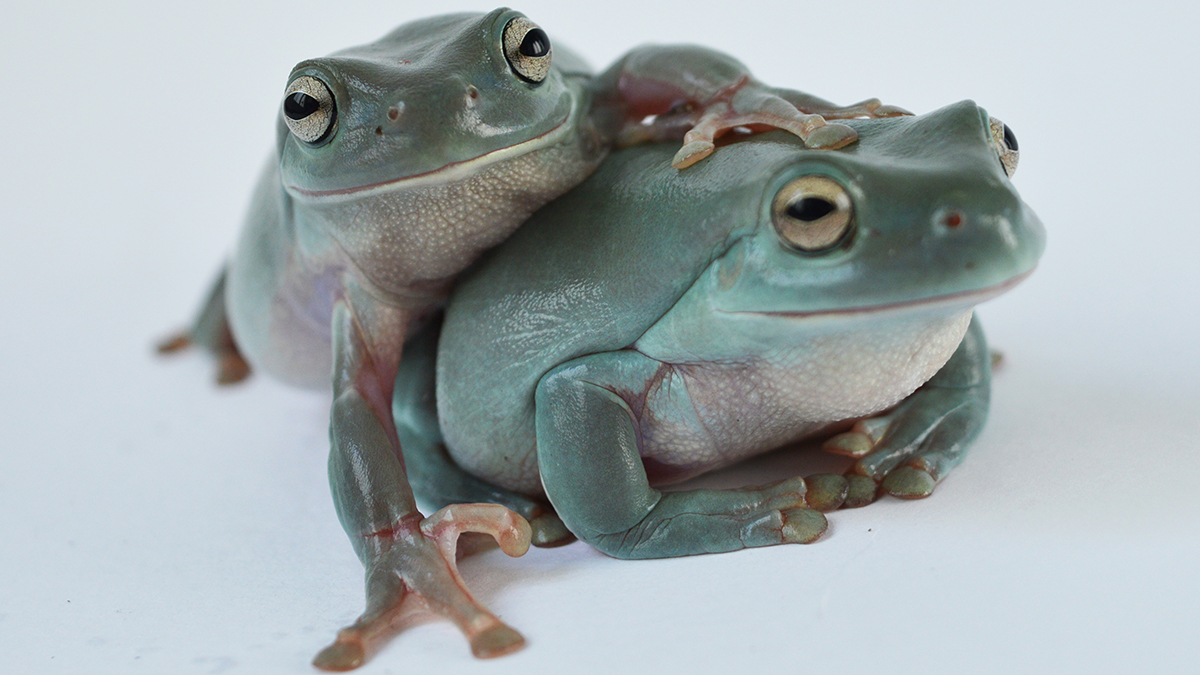
Species Overview
- Common Names: White’s Tree Frog, Dumpy Tree Frog, or Smiling Tree Frog
- Scientific Name: Litoria caerulea
- Distribution: Native to Australia and southern New Guinea and introduced to New Zealand
- Adult Size: up to 5”
- Life Expectancy: up to 20 years; 15 is more common
White’s Tree Frogs are incredibly docile amphibians that are unafraid of humans and often live in close contact with people throughout their habitat. These chubby frogs are also known as Dumpy Tree Frogs because of their plump bodies and the large bulges they grow above their heads as adults. They can range in color from bright green to a beautiful teal blue and sometimes even appear purple. A selectively bred line known as a Snowflake in captivity exhibits extreme amounts of white speckling all over its body. Reluctant to jump, hardy, and significant at 4-5” as adults, these frogs make a great first amphibian pet for anyone.
About the White’s Tree Frog
White’s Tree Frog Pet Care: Habitat Set-Up
Habitat
- The White’s tree frogs need an enclosure with lots of climbing room. If you want to keep more than two juveniles or two adults, be sure the frogs are the same size. If they’re not the same size, more giant frogs will eat smaller ones.
- A tight-fitting lid is essential. These frogs will scale the side of an aquarium. Housing must be sealed and escape-proof with a secured top or aquarium hood.
- Provide lots of sturdy branches, large pieces of cork bark, and foliage for climbing. Keep in mind. These frogs are stocky and need robust terrain. Equally important, the live plants must be free of fertilizer or pesticide residues on the plant or in the soil. Tank cleaning is most accessible if the live plants can be kept in small pots for easy removal.
- Place a large piece of bark diagonally across the cage, a few inches from the back wall. Your frog is nocturnal and needs a quiet place to sleep during the day. This bark provides a safe refuge, as well as adds lush plants. Covering the back surface of the tank with dark paper helps the frog find a secluded and dim area to sleep in during the day.
- Your frog’s cage should be spot-cleaned daily, and the water in the dish should be changed daily or at least every other day.
Heating/Lighting
- Provide the White’s Tree Frogs with a thermal gradient (a warm and a cool spot). The cool side of the cage should be 70-75°F and the basking spot of 80-85°F. Use a thermometer to confirm the appropriate temperature.
- At night, subdue the light, and if the light is needed, use a nocturnal bulb. Provide a 12-14 hour light cycle.
- Be sure to mist the enclosure at least once a day. And, to maintain the White’s Tree Frogs’ habitat, they need between 60-90% humidity.
Substrates
- We recommend using large pieces of bark, large-sized gravel, or soil. We carry substrates that retain moisture and humidity, such as Zilla Jungle Mix or Zilla Coconut Husk Brick. For additional moisture, use Zilla Terrarium Moss. Provide a large, shallow water dish in the enclosure and change it weekly at least 2-3 times.
White’s Tree Frog Pet Care: Temperament
- White’s Tree Frogs are nocturnal, which means they are more active in the evening and night hours.
- A White’s tree frog is an excellent choice for a beginning frog owner.
- White’s tree frogs are passive and docile, can become relatively tame, and tolerate handling. However, amphibians have susceptible skin that absorbs chemicals quickly, so extreme care is needed when handling.
- Wash your hands thoroughly with warm water and rinse well; natural oils and salts found on human skin can be damaging, as can any soap or lotion residue.
White’s Tree Frog Pet Care: Diet and Nutrition
- White’s Tree Frogs should eat a diet of crickets, roaches, and mealworms 2-3 times weekly. Insects can be placed in the cage or offered using blunt-tip forceps.
- The insects fed to the frog should be gut-loaded (increasing the nutritional value of your feeders and helping pass essential nutrients to your frogs). Also, the food should be dusted with a calcium-vitamin supplement (additional calcium, which is vital to keeping a healthy pet) daily in very young frogs, once or twice a week for mid-sized and once a week for mature frogs.
- Fully grown White’s Tree Frogs may even take pinkie mice on occasion. But, be careful not to overfeed them as obesity and other health concerns will become an issue.
- The best way to judge how much to feed is by looking at the frog’s body condition. Look for ridges just above the frog’s eardrum. If there are no noticeable ridges, the frog is likely underweight and should feed more or more often. If the ridges become prominent and start to sag or fold over, the frog is obese and should be eating less.
White’s Tree Frog Pet Care: Water
- Clean, fresh water is critical to keeping all amphibians healthy. We recommend using ReptiSafe® Water Conditioner to treat all water added to your terrarium.
- A Little Dripper™, HabbaMist®, Repti-Fogger™, or Motomister™ is used to add humidity to the enclosure.
- Spray the terrarium daily.
Pet Safety
- Use caution when handling pets, and remember they may bite or scratch (especially when stressed).
- Supervise children around pets.
- ALL ANIMALS can potentially carry viral, bacterial, fungal, and parasitic diseases contagious to humans.
- Thoroughly wash your hands with warm, soapy water before and after contact with any pet or habitat.
- Adults should assist children with handwashing after contact with a pet, habitat, or aquarium water.
Related Searches
Amphibian Care